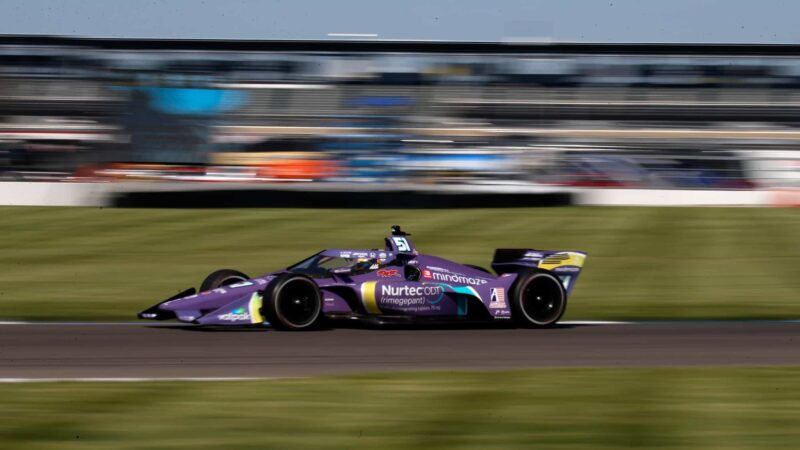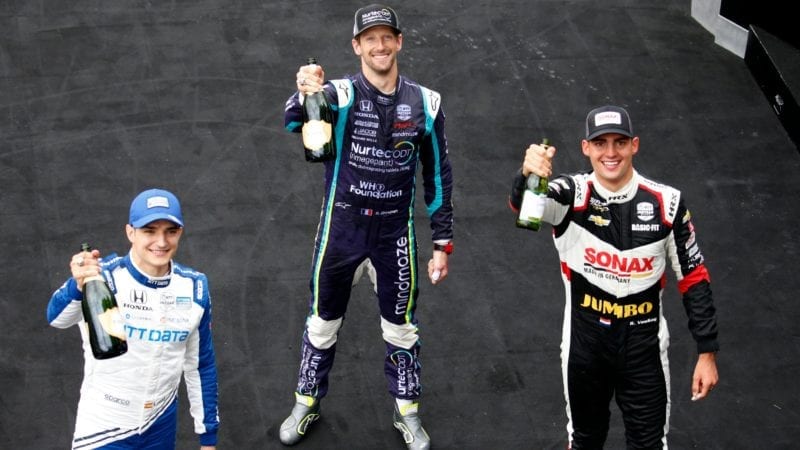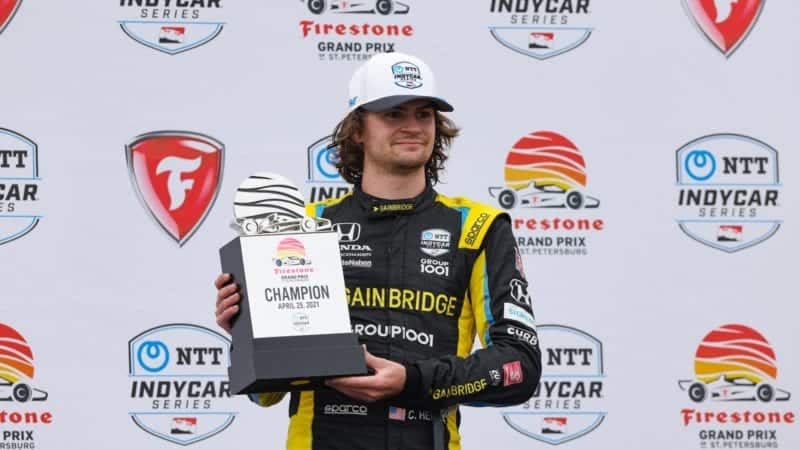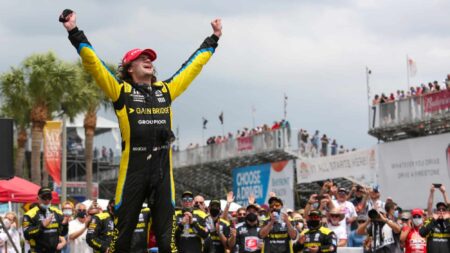When the TV interviewer asked him what he was enjoying about IndyCar so far, Grosjean shot back with a big smile: “leading races,” he said. No wonder. It’s been a while – not that you could notice watching his performance in the first half of that race.
“It’s really a good day,” Grosjean said, clearly still buzzing from the joy of just being alive, to be able to love his family and to find new fulfilment in his sport. “We led at the start of the race and were super-fast. Bahrain was horrible, but for my life, it’s a great experience; the support I’m having [from fans] is incredible. The team did super good. We got a bit unlucky with slower cars, but P2 on my third race in IndyCar is not too bad.”
If he wants it, the 35-year-old has a potentially enriching few years ahead of him in IndyCar that could offer a degree of nourishment that was missing from his life for so many years toiling in the F1 midfield. It clearly suits him. But in direct contrast, the emergence of young talent begs the question whether any of the new-gen can have realistic ambitions to switch the other way – and pertinently whether they should really bother.
Could Palou, Herta, O’Ward and VeeKay hack it in F1? Are they good enough to make the grade? Who knows? Until one or all of them get the chance they deserve to find out, it’s simply impossible to say. Given F1’s renewed focus on the US in the wake of the 10-year deal for the Miami GP to join Austin’s Circuit of the Americas on the calendar from next year, Herta should at least be on the radar, while O’Ward has the most direct link through Brown and McLaren. But even if opportunity knocks, you have to wonder what chance they’d have of grasping a meaningful handhold in F1. IndyCar is a fantastic destination in itself. Why risk it all for a shot at a drive in a code of racing that is an unequal struggle for more than half the grid?

Grosjean has enjoyed his start to IndyCar after switching from F1 but could the young guns go the other way?
Brian Spurlock/Icon Sportswire via Getty Images
Still, I’d put money on all of them being tempted, if there’s even half a chance. It’s F1 after all – still the pinnacle, still the place to find out what you’ve really got. But we’re a long way from 1995 when Williams made Jacques Villeneuve the best-prepared rookie, at least until Lewis Hamilton, when the Canadian made his high-pressure, high-profile switch from CART to the quickest car on the F1 grid. In an era of cost caps and strictly limited testing, such a move would be so much harder today – incomparably so. When a guy like Daniel Ricciardo takes time to get up to speed in an unfamiliar McLaren you know how tough it would be for, say, O’Ward to parachute in beside Lando Norris. F1 is a brutal test of young-driver resilience, application and sheer talent – and yes, it always has been. But I’d argue it’s tougher now than ever. For most, it might as well be on another planet.
But if the Monaco paddock seems a million miles away for IndyCar’s new quartet of youthful winners they are unlikely to care less this week. Their focus right now is purely on the daunting task at hand, as practice begins for the 105th Indianapolis 500 – the race that still means more than all the others put together. If Simon Pagenaud, Will Power, Josef Newgarden or Kiwi V8 Supercar convert Scott McLaughlin win at The Brickyard on May 30, everyone knows the five-race Penske ‘drought’ will pale into immediate insignificance.
Predicting who will win the ‘Big One’ is a little like betting on the Grand National. Sure, back the favourites, but over 500 miles on the four-turn speedway pretty much anything can happen. The new-gen racers will fancy their chances as much as anyone – and to hell with F1 (at least for now…).
As for Grosjean, he’ll be watching on the box, having only committed to a limited IndyCar campaign this year that avoids the ovals. You can hardly blame him given what he and his family have been through, and with the added jeopardy that comes at the races where you only turn left. But still there might well be a twinge of regret for him come May 30. Like the rest of them, he’s a natural-born racer. Even when the odds are stacked against them, racing drivers can’t resist – which is why the old F1 lure will still tug at the new-gen, even if common sense will tell them to leave well alone.



